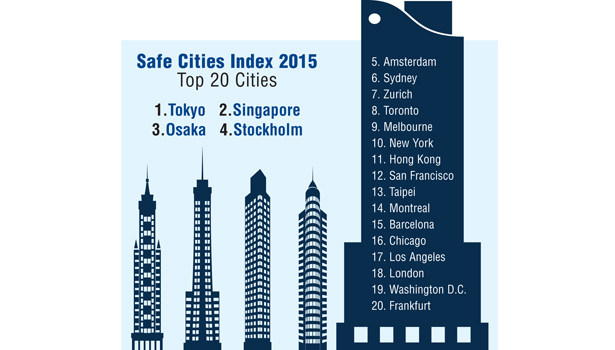Tokyo tops the rankings for overall safest city this year, according to The Economist’s report: The Safe Cities Index 2015: Assessing Urban Security in the Digital Age. By ranking 50 cities under four main categories: digital security, health security, infrastructure safety and personal safety, the report found that the world’s most populous city is also the safest in the Index, especially with preparations underway for the 2020 Olympic Games in Tokyo. The Japanese city ranks in the top five for personal safety and infrastructure safety, despite suffering regular earthquakes and being home to 38 million people, according to the UN. It tops the chart of cities championing digital security.
Tokyo did fall lower in the ranks in the area of health security. This category measures a city’s health security based on many factors, including the ratio of hospital beds to population size and life expectancy. In this category, Zurich in Switzerland tops the chart with a score of 79.05 out of 100. This category includes more than having appropriate measures in place to handle, for example, an Ebola outbreak. Cities ranking high in this area have good air quality, low indoor pollution, and good traffic management to help reduce road accidents. This area in particular calls for more preventative strategies, as well as reactive programs, to help reduce risk.
Zurich rose to the top of the rankings again in infrastructure safety, scoring 92.63 points, followed closely by Melbourne and Sydney in Australia. For older cities, especially western European cities, this can be a challenge, as updating and maintaining infrastructure means renovating centuries-old architecture and systems. The report notes that using technology such as wireless-enabled sensors to monitor the safety of existing structure such as bridges, tunnels, and water and sanitation networks for potential problems can help to find early indicators of trouble so maintenance can be performed as soon as possible.
In areas of personal safety (which measures traditional city safety in terms of crime levels, relying on factors such as police engagement and the prevalence of violent crime), Singapore earned the top spot with 90.42 points, but Barcelona has shown significant improvement. Now at position 11 in the personal safety category, the Spanish city’s council decided to increase the police presence on streets and in the subway, yielding results of a 32-percent drop in crime over the past three years. The law enforcement presence also increased perceptions of safety among the city’s residents.
Technology can help in this regard as well, the report notes. As part of the Future City Glasgow initiative, the Scottish city is developing street lighting systems to react to environmental factors related to crime. At times of low risk, the lights dim to save energy, but if the sensors installed in the lamp posts detect activity or noise, the lights brighten. Security video operators in the city’s new integrated operations center are alerted to unusually high noise levels, such as shouting, and they can then notify the police.

